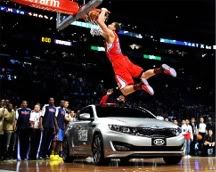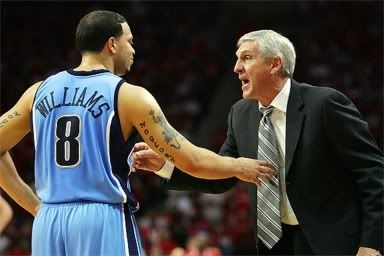In the NBA, being known as a “Franchise Player” is currently considered the highest of compliments. This is going to change fairly soon. It’s about to be viewed as a curse.
When Lebron James and his handlers engineered their infamous “The Decision” circus, they struck many nerves on many people. Clearly, Cleveland and to some extent the state of Ohio took the worst of it, having their collective heart broken in the most public, arrogant and callous way imaginable. In practical terms, when James declared that, “I’m taking my talents to South Beach,” Lebron’s former team the Cavaliers, went from the winningest team in the NBA to record-setting losers.
While most of the country felt genuinely sorry for their Ohio brethren, there was a more gnawing and personal concern felt by many NBA fans. James not only decided to join forces with fellow mega-star Dwayne Wade in Miami, he also brought along 26 year-old 6-10 forward Chris Bosh, a 5-time (now 6-time) All Star in his own right. Overnight, the Heat not only became a contender, they had many experts predicting an invincibility for the team that the league hadn’t seen since the heyday of the Boston Celtics dynasty in the early 1960s.
The problem fans had with this wasn’t simply that the rise of the Heat diminished their own teams’ chances of winning the title. It was bigger than that. The problem was that the Heat was a potential dynasty built by the players themselves…the problem was that it felt like the inmates were running the asylum.
The formula for winning a championship also changed. In the past, you needed one superstar and, as Michael Jordan called it, a talented and complementary “supporting cast.” Suddenly, in order to compete with the Heat, one superstar wasn’t enough. You now needed two and probably a third player who is just below superstar status. This is a problem in a 30-team league that only has maybe 10 true superstars players.
These concerns have been kept alive by Denver Nuggets superstar forward Carmelo Anthony and his season-long quest to be traded. Anthony was the Nuggets designated superstar and the team had used the traditional formula to build around him with quality players like point guard Chauncey Billups, former first overall pick Kenyon Martin, center Nene Hilario and promising shooting guard Aaron Afflalo. The team has had some success, making the playoffs in each of Anthony’s 7 NBA seasons and winning 50 or more games in each of the last 3. However, few experts considered the Nuggets to be a truly serious contender.
To be clear, Anthony is far from the first stud player who has demanded a trade. What made Anthony’s “request” different is that he pretty much made it clear exactly where he wanted to be traded. He wanted to go home to the New York Knicks where he could form another two-superstar tandem with perennial All Star forward/center Amare Stoudemire. As the world now knows, “Melo” got exactly what he wanted.
It’s not surprising that “solo-superstar players” like the Orlando Magic’s Dwight Howard and New Orleans Hornets’ point guard Chris Paul are beginning to question whether their teams can effectively compete against these multi-superstar teams. Both can become free agents after next season and there are already rumblings about them leaving to form two more superstar-studded teams.
Although NBA owners would never admit it, the increasing trend of star players looking to move for reasons not directly related to money is a bed that they themselves made. In their 1999 collective bargaining agreement (CBA), they insisted on imposing a maximum salary scale, the first and still the only such provision in major professional sports. Though there are some retention advantages granted to a player’s current team (they can offer higher annual raises and one more year in contract length), a “max player” can make about the same amount of money whether they stay or go. Also, with the prevalence of “sign and trade” agreements, if a player can force a trade prior to their free agency, he can get exactly the same money and contract length with a new team as he could have gotten with his current team.
The ultimate result of making salary fairly neutral in the stay-or-go decision is a matter of common sense…players will weigh their alternatives based on non-salary considerations…like increasing their odds of winning a championship, endorsement opportunities and/or a more desirable locale.
For a league already suffering from a serious “haves and have-nots” problem, the consolidation of superstars on a small handful of teams is not a positive trend nor is the fact that it’s the players who are orchestrating this change. There is growing sentiment among fans that something needs to be done. This is particularly strongly felt among fans of small and mid-market teams who are most likely to be the ones who will be unable to attract or keep top-tier talent.
If you’re one of these concerned NBA fans, fear not. Your timing is excellent and help is on the way. This is because the CBA between the NBA and the National Basketball Players Association (NBPA) expires at the conclusion of this season and you can bet that restricting the movement of star players will be on the NBA owners’ agenda. Fortunately for the owners, they won’t need to wrack their brains to come up with some clever and effective solution. Their friends at the National Football League have been there and done that.
The NFL’s “Franchise Tag”
The NFL’s franchise tag has been a part of their CBA with the players since 1993. It is used as a way of keeping star players from leaving their current teams, but it’s both expensive and temporary.
In the NFL, a team may designate only one player with the franchise tag each year and the same player may only be franchise-tagged for two seasons in succession. There are two types of franchise tags – exclusive and non-exclusive.
If a team uses the exclusive franchise tag on a player, that player must play for his current team for the following season. The salary for that player is set based on the average salary paid to the top 5 players at his position (in 2010, these ranged from $16.4MM for a quarterback to $2.8MM for a placekicker or punter).
Non-exclusive franchised players are allowed to negotiate with other teams for a new contract. However, similar to “Restricted Free Agency” in the NBA, if the player receives an offer, his current team can match it and retain the player’s services. Should the current team choose not to match the other team’s offer, the current team receives two future first round draft picks as compensation.
Despite the high salaries mandated by the franchise tag rules, NFL star players pretty much unanimously hate the franchise tag. The primary reason is that most NFL contracts include a signing bonus, and for star players, these signing bonuses can be huge…often 20-30% of the contract’s total value. Franchise tag salaries do not include signing bonuses, and given the very short average careers of NFL players, being “tagged” may mean missing out on a once-in-a-lifetime financial opportunity. For this reason, even the mere threat of the franchise tag can often be sufficient motivation to get a long-term deal done.
Tagging in the NBA
While no one in an official NBA capacity has said that they’ll be looking to put a franchise tag provision in the new CBA, it seems like a natural fit and one that will be popular with fans. Because of this, insisting on a NBA franchise tag will have a lot of public relations value for NBA owners. Furthermore, NBA owners can point to the decades of success the NFL has enjoyed using the franchise tag.
While the NBA can easily borrow the franchise tag concept from the NFL, they’ll need to work out their own mechanics for it. For example, I don’t think that the NFL’s “non-exclusive” tag would work in the NBA. As noted, if a NFL team goes the non-exclusive route and elects not to match the offer, they are compensated by getting two first-round draft picks from the other team. In the NBA, the difference between the quality of players at the top of the first round of the draft and those at the bottom is simply too great…getting two late first-round picks for a superstar is akin to getting 10 cents on the dollar. Another difference is that, unlike the NFL, the NBA would not need to establish a schedule of franchise tag salaries based on the position a player plays since top NBA players are found at each of the 5 positions on the floor.
To make the franchise tag a little more palatable to the players, NBA owners may just want to keep it fairly simple:
A player who is scheduled to become a free agent may be tagged as a franchise player and will be paid the maximum salary (in the NBA this is based on a player’s number of years in the league) for that season. Like the NFL, a team would only be allowed to name one franchise player per year and a player may only be tagged for 2 seasons in succession.
Again, the top players will hate it, but since the vast majority of NBA union members would be unaffected by the franchise tag, it’s unlikely that it would be a deal breaker. In fact, this “divide and conquer” strategy is exactly how the owners were able to put their unique maximum salary provision into the 1999 CBA.
When the negotiating rhetoric begins in earnest after this NBA season, the owners’ underlying theme will be the need to bolster their small/mid-market franchises. As the sorry state of the New Orleans franchise (the team is currently owned by the league) has shown, even with a superstar (Paul) it can be tough to make a go of it. Without Paul, they have no chance.
On the court, players like Paul and Howard are virtually unstoppable, but any dreams they may have of taking their talents elsewhere are about to be crushed. Chris and Dwight…tag, you’re it.


